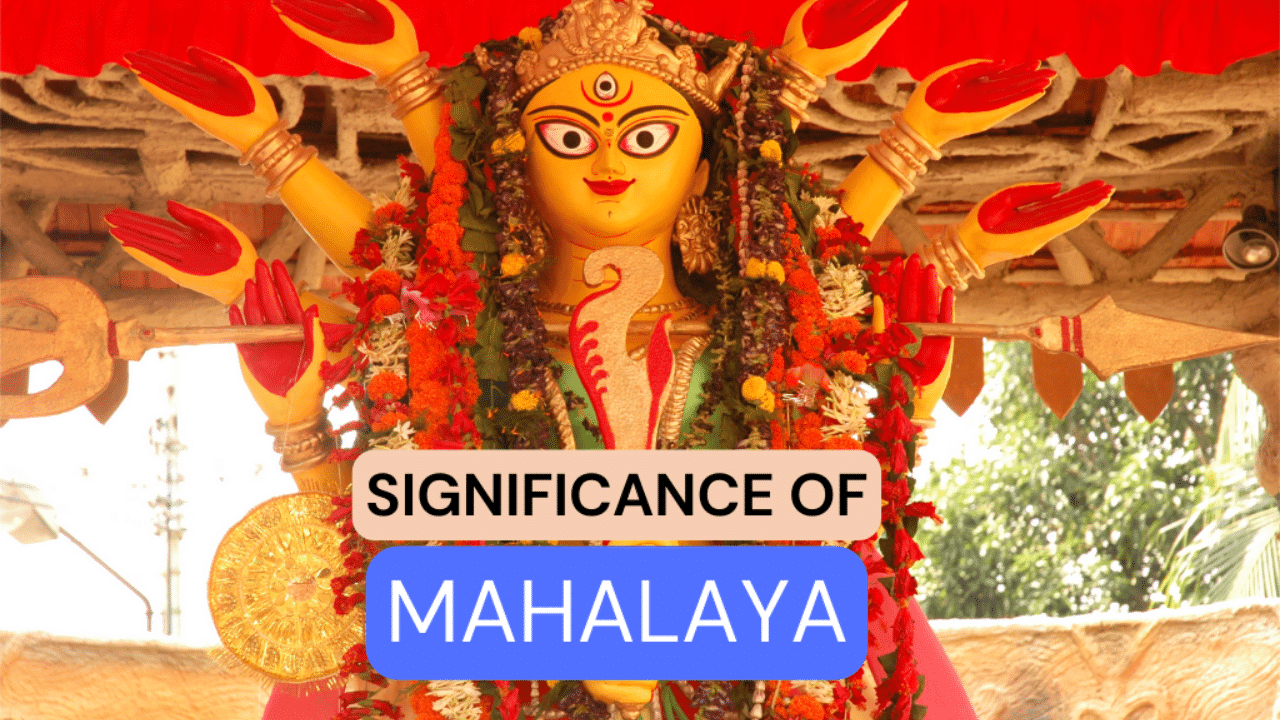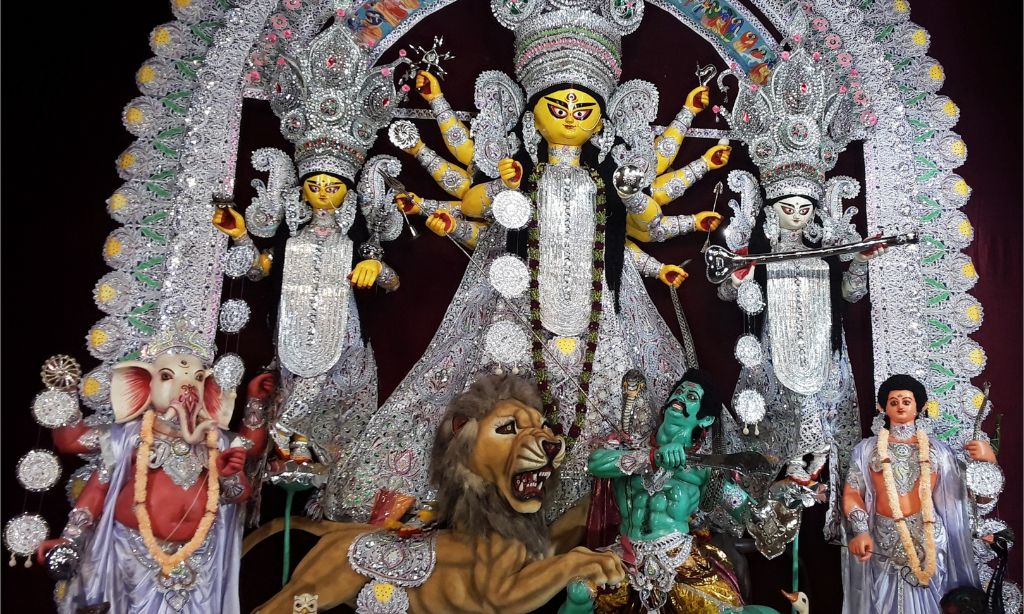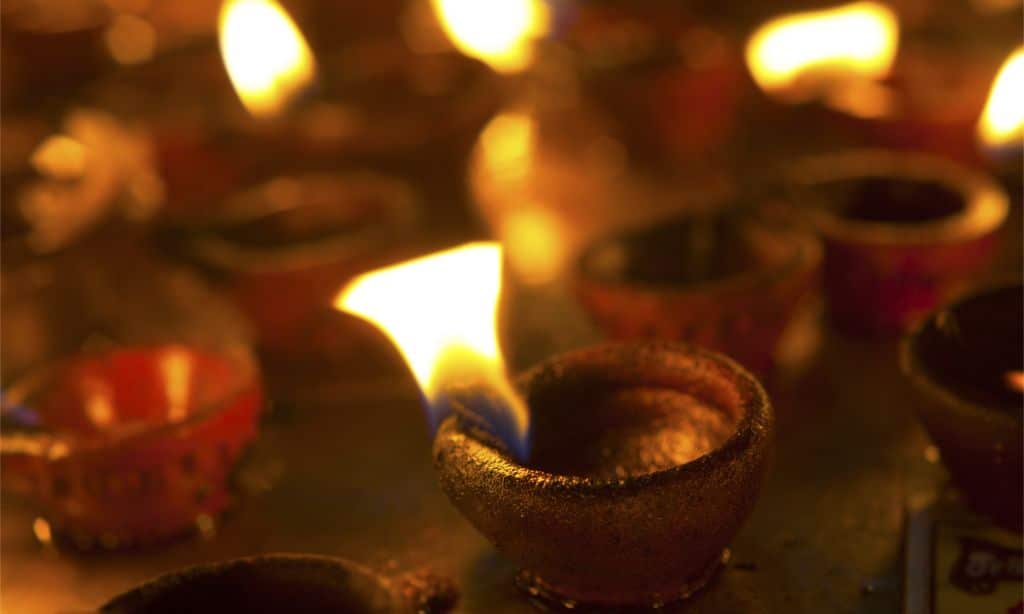Mahalaya is an important cultural event in Hinduism celebrated with great enthusiasm. It marks the beginning of Devi Paksha, signals the end of Pitri Paksha, and marks the homecoming of Goddess Durga to Earth. This year the Mahalaya will held on October 14, 2023.
This article looks at the significance of the Mahalaya for Hindus culturally and provides all relevant information about correctly observing this special occasion. Celebrating Mahalaya does more than just relish in festivities; it honors religious beliefs that celebrate peace, righteousness, courage, and spirituality – a must-read blog post!
Content Highlights
- Mahalaya marks the spiritual homecoming of goddess Durga on Earth and her triumph over Mahishasura, a powerful demon king.
- Hindu devotees celebrate this annual event by performing various rituals and ceremonies such as Pitru Tarpan, Chokkhu Daan & Kola Bou and chanting mantras to seek blessings from Goddess Durga and their ancestors.
- This multicultural festival symbolizes good prevailing over evil through devotion toward gods with long-standing beliefs that paying homage to one’s forefathers would bring peace and harmony on earth.
- Apart from religious observances associated with it, this festival offers an opportunity for Hindus not just to enjoy festive cheer but also take pride in sharing cultural heritage amongst people everywhere transcending caste system or regional divide unifying them all under a common thread of celebration every year during Devi paksha before Navratri commences.
The Significance of Mahalaya in Hinduism
Mahalaya marks the start of Devi Paksha, which is a 16-day long period in preparation for the celebrated Durga Pujo festivities. It signifies the triumph of good over evil and celebrates Goddess Durga’s descent to Earth.
The beginning of Goddess Durga’s descent
Mahalaya marks the start of the Durga Puja festivities and is celebrated by devotees of Maa Durga as the official descent of Goddess Durga on Earth. The day is considered significant culturally for Hindus, marking Devi Paksha or the fortnight immediately leading up to Navratri and ending Pitru Paksha, a period for paying homage to one’s deceased ancestors.
Mahalaya signifies an epic battle between gods and demons that was fought according to Hindu mythology in order to overcome evil. The most important aspect of this festival is worshiping goddess Durga as she ultimately destroyed demon Mahishasura who had wreaked havoc on all deities with his powers – until slain by devi maa Durga at last after being blessed by Brahmadev, Shiva, Shakti & Vishnu.
It symbolizes spiritual strength over any form of evil or darkness in life making it very important religiously among Hindus from various communities both within India and around the world without caste-based discrimination.
Preparation for Durga Puja
Mahalaya marks Goddess Durga’s homecoming and starts with elaborate preparation for her worship. It is an auspicious day that signals the beginning of festivities, with rituals, prayers, and offerings to invoke the blessings of Maa Durga.
During this time, families clean their homes in order to ensure a fresh start for the festive days ahead when they will welcome Goddess Durga into their homes. Decorative pandals are also constructed wherever public celebrations take place in honor of Maa Durga as rituals such as Kola Bou (bouquet offering traditionally made from banana stalks) and Chokkhu Daan (donations) also take place during Mahalaya.
On Mahalaya, elderly members in Bengali households perform Pitru Tarpan or water oblations, symbolically expressing love to one’s ancestors. This ritual is performed by pouring sacred items like clarified butter, sandal paste, and flowers into a pot filled with water while chanting mantras dedicated to Goddess Durga marking her descent on Earth each year at this time. You can also read about- Celebrate the Birth of Lord Krishna on Janmashtami.
Rituals and Customs
Mahalaya marks the start of Devipaksha or Durga Pujo, a major festival in Bengali culture. Associated with various rituals and customs, it ushers in a period of celebration dedicated to Goddess Durga’s descent from Devlok (heavenly abode) as she prepares to fight Mahishasura, the demon king.
Prayers are offered to ancestors through tarpan and special puja offerings such as Kola Bou – seven types of edible foodstuffs placed atop banana leaves during puja ceremonies. Other traditional activities include chanting mantras and listening to devotional songs that chronicle the well-known battle between gods and demons for planetary supremacy.
These religious observances serve not only to honor departed family members but also offer thanksgiving for blessings from Maa Durga all around the world. It is observed primarily by Hindus who feel deeply connected with their Mother Goddess, enjoying her festive presence and celebrating her triumph over evil forces every year with great devotion.
The Story of Mahalaya
The Mahalaya story narrates the arrival of Goddess Durga on Earth to destroy the demon Mahishasura in a fierce battle after being requested by gods and goddesses.
Arrival of Goddess Durga on Earth
Mahalaya marks the beginning of Goddess Durga’s journey from Mount Kailash to Earth. According to Hindu mythology, Durga was created on Mahalaya as an incarnation of Shakti in order to defeat the demon king Mahishasuramardini.
This day is celebrated as a festival of homecoming because it symbolizes her arrival with her four children – Ganesha, Kartikeya, Saraswati, and Lakshmi – who accompany her during this auspicious occasion.
Hindus celebrate Mahalaya as both a significant cultural event and an important spiritual celebration. It shows respect for goddess worship by honoring their presence and power among people on earth.
Hindus observe various rituals and offerings during this time, such as Pitru Tarpan (a ritual dedicated to ancestors) and chanting mantras to praise Durga Maa’s position amongst gods within the Hindu religion.
Celebrated mainly within the Bengali community, it is seen not just as a religious observance but also partakes in various cultural traditions like Chokkhu Daan (the festivity tradition wherein Bangalis feed birds), sharing sweets like Kheer or Payesh & Kola Bou (planting banana saplings).
The epic battle between gods and demons
Mahalaya marks the beginning of Goddess Durga’s descent from Mount Kailash to earth and is traditionally seen as a spiritual fortification for mankind against evil. It commemorates an ancient mythological battle between divine beings and mythical creatures that is said to have taken place during this auspicious time.
This epic showdown was between Devi Adi Shakti aka Goddess Durga, who came down in answer to prayers uttered by all divinities along with Lord Vishnu, against Mahishasura, a powerful demon king ruling over the earthly realms.
The tale goes on to narrate how Devi overcame dark forces through her instrumental divinely given weapons and finally vanquished him after they fought for nine nights or Navratri days.
Triumph over the demon Mahishasura
is a significant event in Hindu mythology and has strong cultural significance. In this myth, the demon Mahishasura had defeated the gods led by Indra, seized heaven, and gained a powerful boon that no man could kill him.
To restore balance in the universe, Goddess Durga was created by Brahma, Vishnu, and Maheshwar on Mahalaya Amavasya day to vanquish Mahishasura and his armies. The epic battle between Durga and Mahisahsur finally resulted in the victory of Goddess Durga on Earth which reestablished control of Heaven to devas led by Indra.
Her victory symbolized joy for restoring justice in chaos/evilness represented by demons while also signified that justice prevails over all wrongdoings reflecting an eternal truth that good always trying evil will eventually result in success regardless of how hard it may lurk deep down inside us yetil can be defeated eventually with courage.
Mahalaya Amavasya 2023: Date and Significance
On October 14, 2023, Hindus will celebrate the day with traditional customs and rituals to seek blessing from Maa Durga for prosperity in life. Read more to understand its spiritual significance!
Blessings from Maa Durga and their ancestors
Mahalaya Amavasya is a festival of great cultural significance in Hindu tradition, celebrated on 15th July 2023. It marks the beginning of Goddess Durga’s descent to Earth to fight against evil and restore peace.
Observing Mahalaya brings blessings from both Maa Durga and one’s ancestors for good health, wealth, and prosperity. It is believed that pleasing their ancestors releases positive energy upon the living, bringing happiness and blessings to them.
The Mahalaya rituals involve offering special Pujas to Goddess Durga as well as performing Pitru Tarpan for ancestor worshiping ritual found in ancient Hindu scriptures such as Veda’s Reading about Lord Rama’s victory over Ravana by being blessed by his ancestors followed by prayer recitation forms part of this spiritual celebration.
People perform Chokkhu Daan & Kola Boi – offerings made to one’s elders during the Mahalaya Amavasya puja- following its procedure outlined in Rig Veda hymn 10 verse 16:5-7 praying for long life and prosperity of one‘s forefathers.
Observance of Rituals
Mahalaya Amavasya is an important fortnight of the Hindu calendar and is observed on the new moon day. It marks the start of Durga Puja celebrations, and is a time for honoring ancestors by performing rituals and making offerings that bring blessings from Maa Durga.
Offerings made during this time include food, water, prayers to departed ancestors, and flowers in temples dedicated to goddesses such as two sisters – Saraswati & Lakshmi. This period provides an opportunity for introspection and reflection on one’s roots and ancestral lineage.
For Bengali communities, these rituals form an integral part of their culture emphasizing strength through unity with familial ties which gives them reason to celebrate annually with great enthusiasm!
Chokkhu Daan and Kola Bou
Chokkhu Daan and Kola Bou are two important rituals performed during Mahalaya Amavasya. The ritual of Chokkhu Daan is symbolic of surrendering one’s ego to seek divine vision by offering their eyes to Maa Durga.
This represents a spiritual journey from physicality to spirituality, in which the devotee realizes that the true victory lies not through worldly possessions but in inner peace attained through devotion and knowledge.
The second ritual, Kola Bou involves bathing a banana tree with water while chanting mantras; this symbolizes invoking Goddess Durga on Earth as she was believed to have first set foot on earth atop such a tree.
Mahalaya Amavasya Puja Procedure
On this sacred day, several rituals and offerings are made such as Pitru Tarpan, mantras chanting, and making food/flower/fruit offerings to Maa Durga.
Pitru Tarpan
Pitru Tarpan is an important ritual associated with Mahalaya Amavasya Puja, whose observance marks the start of Dussehra celebrations and provides an opportunity to honor one’s ancestors.
It involves offering water or other items such as Sesame seeds or flowers and reciting sacred mantras and prayers, symbolizing nourishment for their souls in the afterlife.
The eldest male member in a family typically leads this ancient ceremony while all other members watch reverently. This helps establish stronger connections between generations, acknowledges traditions that have been passed down over time, and brings peace to the spirits of deceased forebears.
Mantras to chant
Chanting mantras is an important custom during the Mahalaya Amavasya Puja. These mantras invoke the blessings of Goddess Durga, seek success and well-being, and eliminate sins from one’s life path.
The most commonly chanted mantra on this occasion is the Gayatri Mantra, which is believed to be a powerful purification chant for both physical and spiritual energy. Additionally, chanting Vishnu Mantras is said to bring great fortune during this ritual while following all prescribed procedures as mentioned in Hindu scriptures like Bhagavad Gita and Puranas.
It further helps in aligning with universal energies that lead us toward greater peace, joy, love, harmony, and prosperity.
Puja rituals and offerings
Mahalaya is celebrated seven days before Durga Puja and is a day of ancestral worship. Hindus observe special rituals to pay obeisance to their ancestors, express gratitude for the blessings and protection they have received, and seek divine favor from them.
Commonly known as Pitri Paksha, devotees perform Shraddha rituals on this day including offering flowers, incense sticks, and food items such as fruits and sweets to please their ancestors.
There are also offerings like Tarpan or Chokkhu Daan that are made while praying to the gods in order for the souls of departed ancestors to get peace. The observance of Kola Bou (planting banana saplings) on Mahalaya is very significant as it symbolizes prosperity and growth throughout all generations.
Mahalaya and Hinduism
Mahalaya is a significant festival in the Hindu culture as it celebrates the triumph of goddess worship and spiritual enlightenment.
Importance in the Hindu culture
Mahalaya is of great importance in the Hindu culture, been celebrated for centuries as it marks the end of ‘Krishnapaksha,’ the dark fortnight of Ashwin month. This is believed to be when Goddess Durga starts her official journey from Kailash Parvat near Mount Sumeru and descends to earth, marking a spiritual connection between gods and humans.
Popular rituals associated with Mahalaya include Chokkhu Daan (offering eyes) and Kola Bou Puja (plantain offerings). It also serves as an occasion to invite back ancestors who have passed on for blessings; close family members perform Tarpana or Pitru Tarpan with mantras chanted before idols of deities.
Therefore, Mahalaya precedes one of the most opulent festivals on the calendar- Durga Puja – preparation and celebration that honors the goddess worshiped in the Hindu religion, emphasizing inner strength amidst battling negativity in life like honesty triumphing over falsehood & bravery conquering fear.
Spiritual Significance
Mahalaya marks the beginning of Devi Paksha and the end of Pitri Paksha, moon cycles dedicated to goddess worship and ancestor worship respectively. During this significant day, Goddess Durga officially begins her journey from Mount Kailash in heavenly realms to Earth on an aahuti (invocation) by Brahma, Vishnu, and Maheswar – coming together to create a powerful female form out of their collective divine qualities with the sole purpose of defeating the demon king Mahishasura.
Therefore for Hindus all over India and beyond, especially those belonging to the Bengal or Oriya community, where festivities revolving around Mahalaya are celebrated with grandeur each year, it is a time-honored tradition that involves honoring ancestors through puja rituals.
With offerings such as ‘Chokkhu Daan’ and ‘Kola Bou’ it is believed blessings will be granted from both goddess Durga during Devi Paksham as well as ancestors during Pitru Paksham for a prosperous life ahead while seeking forgiveness from them for any wrongdoings committed in past particularly if family conflicts have arisen.
Celebration of goddess worship
Mahalaya is a special occasion in Hinduism that celebrates the divine mother goddess Durga. Associated with the festivities of Durga Puja, it marks the beginning of an annual tradition involving this powerful goddess’s worship and veneration.
The theme of goddess worship amidst Mahalaya impels people to connect with their spiritual beliefs and inner strength. It also symbolizes hope and victory over evilness, as Goddess Durga was central to slaying demon king Mahishasura during this time.
Throughout traditional Hindu ceremonies, devotees chant mantras, offer prayers, perform rituals, and honor Maa Durga’s contribution to humanity throughout her Avataras (incarnations).
It is said that fulfilling these ceremonial procedures will bring kindness towards others and invoke blessings from ancestors who find peace on this day due to offerings made on their behalf.
Mahalaya and Bengali Community
As Mahalaya is an important part of the Bengali culture, it brings the whole community together to celebrate the auspicious occasion with elaborate rituals and festivities. Dive into this piece of writing to understand its cultural purpose!
Cultural traditions and practices
Adopting legendary Hindu beliefs, Mahalaya is celebrated with great joy and devotion by the Bengali community. Ancient texts dictate that on this day Goddess Durga begins her descent to earth meaning it marks the start of Devi Paksha and a new cycle of existence.
To commemorate, Bengali households wake up early in the morning even before sunrise to perform religious rituals such as Chokkhu Daan, playing traditional drums called Dhak along with offerings to goddess Durga like Kola Bou (Bananas).
Marriageable age Bengali girls dress up just like brides to seek blessings from Maa Durga for prosperity and fertility in their lives. This is also the time when many Hindu deities are worshipped using Vedic mantras, gaining purification for ancestors’ souls or Pitru Tarpana offering essential materials for the afterlife.
Festive atmosphere
Mahalaya is a special time in the Bengali calendar, with an electric atmosphere of anticipation and excitement. As the predawn darkness of Mahalaya breaks, it resonates with the blowing of the sacred conch shell – which symbolizes divine help being blessed upon mankind.
This spiritual ambiance reflects the preparations for Durga Puja – one of India’s most revered festive celebrations in Hinduism; from West Bengal to Assam, Odisha to Bihar, people come together to offer prayers and seek blessings from Maa Durga.
Mahalaya marks the beginning of Goddess Durga’s descent on Earth as per mythology, setting off a wave of emotions among Bengalis throughout India that cannot be contained! The intensity has only seemed to pick up year by year making this festival harder and harder for those involved to forget or ignore its importance culturally.
Community celebrations
Mahalaya is celebrated with great enthusiasm and fervor among Bengalis, the celebration carries a sense of unity for everyone from various parts of society. It marks the beginning of Devi Paksha or Durga Pujo, giving people an opportunity to pay homage to Goddess Shri Durga and welcome her arrival on Earth.
People decorate their homes and shop fronts as an offering to Goddess Durga; they also perform ‘Kola Bou’ using rice flour by drawing footprints showing the path where she will walk.
Chokkhu Daan is another ritual that takes place during these celebrations when devotees offer sweets made out of cream, bananas, or sweet pumpkin in puja temples to please Maa Durga.
Takeaway
Mahalaya is a cultural event of great significance for Hindus, particularly the Bengali community. It marks the homecoming of Goddess Durga and celebrates her victory over evil with rituals and ceremonies.
This annual festival provides an opportunity to honor ancestors, seek divine blessings from Maa Durga, and cherish a sense of belonging in both Hinduism and Bengal culture. It is also associated with stories that impart lessons about truth, courage, strength, and devotion – values essential to society.
An occasion dedicated to legendary deeds as well as the celebration of life is indeed an auspicious one!
Frequently Asked Questions (FAQs)
Check the answers below if you still have queries about the Mahalaya and its significance.
1. What is Mahalaya?
Mahalaya is a Hindu festival celebrated mainly in Bengal, India. It marks the start of Durga Puja and serves as an invocation to Goddess Durga.
2. When does Mahalaya take place?
Mahalaya usually takes place around 6 weeks before Diwali and typically lasts for 7 days, starting from the day of “Nabami” (eighth day).
3. How do people typically celebrate Mahalaya?
People typically celebrate Mahalaya by making colorful clay idols of Goddess Durga and her children, chanting hymns devoted to the goddess, and offering special prayers within temples or at home altars known as ‘bodhon.’













































